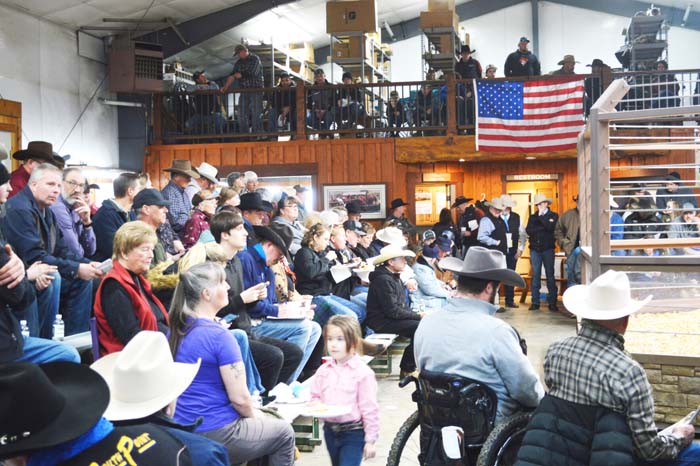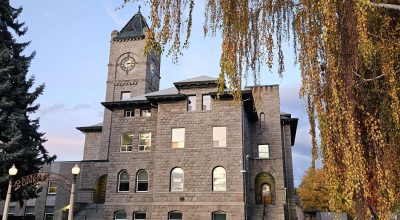Bullish on the business: Harrell Hereford Ranch’s 44th annual spring sale a success
Published 12:30 pm Wednesday, March 8, 2023

- Participants watched the parade of stock animals as Edna Harrell (left center, in the red vest) watches them in turn, as she has since the auctions began 44 years ago.
Edna Harrell sat beside the auction ring as the tradition she started on her family’s Hereford cattle ranch continued for the 44th year.
“It started with me, I was the first,” Harrell said on Monday, March 6 during the annual spring production sale at the Harrell Hereford Ranch along Salmon Creek west of Baker City.
“Then my daughters and son, their kids and the grandkids.”
The sale, which featured 150 yearling and two-year-old bulls, 25 Angus yearling bulls, 35 registered Hereford heifers, 80 commercial heifers and 25 Harrell-Mackenzie quarter horses, brought hundreds of people from several states on a sunny but chilly late winter day near the base of the Elkhorn Mountains.
Edna’s son, Bob Harrell Jr., said after the event that he was pleased with the results.
“We were just very fortunate to have a very great day, all aspects of it was just outstanding, we thought, so it was very gratifying,” he said. “And a great crowd. I don’t know how many we had, maybe 300 to 350, the bull deals were strong, and the heifer deals were strong.”
The top bull brought a bid of $56,000, with the top quarter horse fetching $20,500.
Harrell said the results reflect a strong cattle market, with ranchers willing to spend money to ensure their commercial herds have top genetics.
“There’s getting to be more meatpacker capacity for our area, creating demand for livestock,” he said.
Harrell says he was grateful for the community involvement in the event.
“It takes a family and friends, and employees, it takes a big crew to put one of these things on,” he said.
Edna and Bob Harrell Sr. started the Harrell Hereford Ranch in 1970.
Bob Harrell Jr., who graduated from Baker High School in 1979, was inducted into the Hereford Hall of Fame in Kansas City, Missouri, in 2021.
On Monday inside the ranch’s multi-use pavilion, the auction ring became the center stage for serious transactions.
Outside, rows of trucks, trailers and cars were parked, the line extending nearly to Pocahontas Road
Prior to the sale, the pavilion was abuzz with conversations as people lined up to score plates of home-cooked staples such as brisket, chili, salads and rolls.
Paul Elsner of Caldwell, Idaho, who trains the quarter horses that also go on the auction block (the horse sale was added 25 years ago), was on hand with his wife, Chloe, and their baby girl, Hallie.
Paul Elsner talked about his technique for transforming unbroken horses into animals ready to be ridden 60 days later.
“I try not to make it too intensive, try to make it an easy, fun process, get them willing to learn, as any teacher,” he said. “I came up just for a couple of months, this will be my third year with (the Harrells and Mackenzies).”
Edna Harrell talked about how she has enjoyed seeing the annual sale become more popular as the Harrell Hereford Ranch has expanded over the past 52 years.
She also joked about how some new employees require a bit more education than others.
“They’ll ask whether that’s a cow or a bull or a steer over there,” she said with a laugh. “Well, clearly it’s a bull. Sometimes I have to teach my new employees the difference between them.”
Although bulls and heifers as always were a big part of the sale, the Harrell-Mackenzie quarter horses also attracted potential bidders.
Rancher Brad Cameron of Centerville, Washington, who has been attending the Harrell sale for about 15 years, was searching for a replacement for his ranch horse.
Cameron said the popularity of the sale has brought in new groups of bidders, in some cases pushing prices beyond his budget.
“The word got out on these horses, so now the rodeo guys and the team ropers come and get them, and they’ve got a deeper pocket book than I’ve got,” Cameron said.
Although the Harrell sale is serious business for ranchers, it’s also a social event.
Ranch hands and others settled in by a fire outside, including several of Bob Harrell Jr.’s longtime friends.
They enjoyed the barbecue lunch and shared stories of growing up with Harrell.
“We come every year — they used to let us work, but now they tell us to just stay by the fire,” said Mike Rasmussen. “Since it’s going on record, let’s talk about Bob winning the student art show in South Baker Elementary School.”
“1972, he won with this painting, it was awesome,” Ken Nelson chimed in.
“Turns out, Bob has a projector on the wall and must have traced it, basically cheating,” Rasmussen said with a smile.
“Edna probably painted it,” said Rick Bighan, also laughing.
Rob Thomas is excited about the financial prospects for cattle ranchers in Baker County, and elsewhere, over the next few years.
With the nation’s beef cow herd relatively small even as consumer demand is strong, the situation is promising for ranchers, said Thomas, who owns Thomas Angus Ranch near Baker City.
“We’re very, very optimistic,” Thomas said on Tuesday, March 6, a week after the ranch’s spring bull sale on Feb. 28.
“We were thrilled,” Thomas said. “It was a really, really strong sale, with bulls going to ranches across the country.”
The combination of a low beef cattle inventory, strong consumer demand and rising capacity in the meatpacking industry means packing plants are “fighting for cattle,” Thomas said.
That puts ranchers in a strong position.
“This is one of those rare times when the cattleman is in control,” he said.
The U.S. Department of Agriculture is forecasting an 8% increase in fed-steer prices this year.
Widespread drought was largely responsible for ranchers culling their herds, leading to the low inventory, Thomas said.
And although many ranchers have started to rebuild their herds, he said they’ll have to take some of their heifers out of supply chain, which will extend the current situation of demand outpacing supply.
Thomas figures it will take two or three years for the situation to change.
He said the Feb. 28 sale, and two previous sales over the past several months, all brought higher prices than in the past few years.
Thomas said the strong cattle market creates an economic multiplier, particularly in places such as Baker County where ranching is a major industry.
“It’s good for us, it’s good for everyone,” he said.
— Jayson Jacoby
More Local





